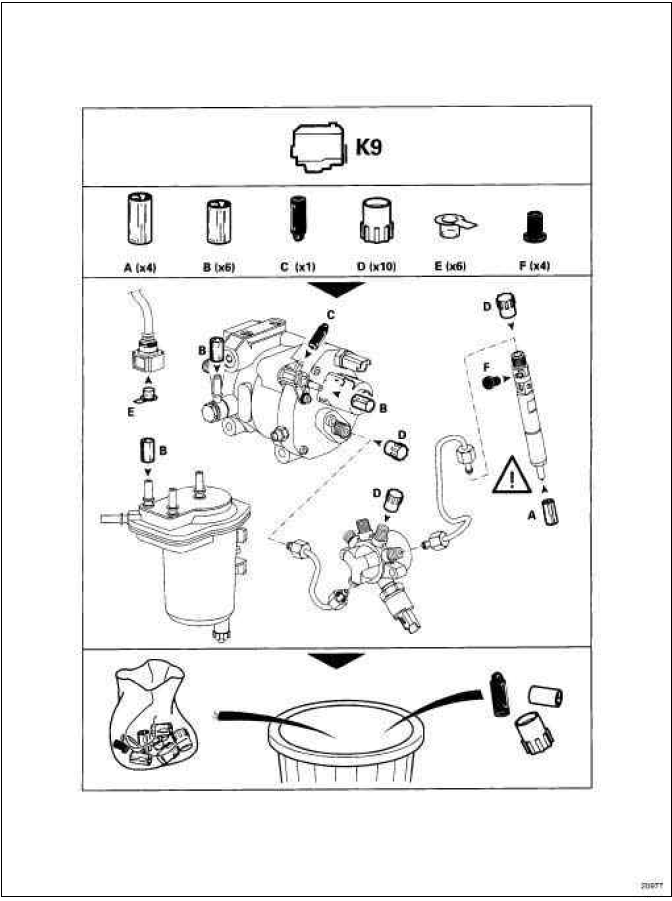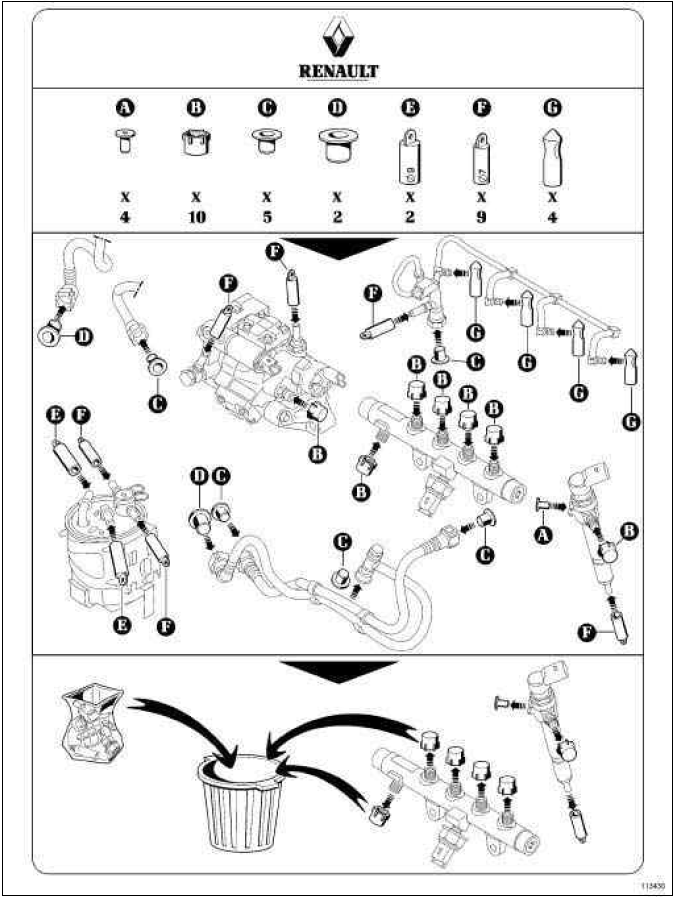Renault Clio: Diesel injection: Precautions for the repair
K9K
I - RISKS RELATING TO CONTAMINATION
The high-pressure direct injection system is highly sensitive to contamination. The risks caused by contamination are:
- damage to or destruction of the high pressure injection system,
- a component seizing,
- a component not being properly sealed.
All After-Sales operations must be performed under very clean conditions. Having carried out an operation in good conditions means that no impurities (particles a few microns in size) have penetrated the system during dismantling.
The cleanliness principle must be applied from the filter to the injectors.
What are the sources of contamination?
- metal or plastic swarf,
- paint,
- fibres:
- cardboard,
- brushes,
- paper,
- clothing,
- cloth,
- foreign bodies such as hair,
- ambient air,
- etc.
WARNING
Do not clean the engine with a high pressure cleaner to prevent damaging the connections.
1 - Cleaning cloths
Use lint-free cleaning cloths (see Vehicle: Parts and consumables for the repair) (04B, Consumables - Products).
It is prohibited to use cloths or ordinary paper towels: these produce lint and lose fibres, which then contaminate the fuel circuit.
Each cloth must only be used once.
2 - Blanking plugs
The blanking plugs are used to cap the fuel circuit once it is opened and to therefore prevent contaminants from entering.
A set of blanking plugs should be used once only and used plugs must be discarded after use: once used, the plugs are soiled and cleaning them is not sufficient to make them reusable.
Unused plugs must also be discarded and must not be used when carrying out work on an injection system.
Part number for set of blanking plugs: (see Vehicle: Parts and consumables for the repair) (04B, Consumables - Products).
Note: There is no specific set of blanking plugs for S9U and S9W engines. In order to comply with the cleanliness recommendations, use plugs that are compatible with the blanking plug sets for F9Q, G9U, G9T or ZD3 engines.
3 - Protective bags
Use hermetically-resealable plastic bags, using adhesive tape, for example, to store components which will be refitted and reused. Stored parts will therefore be less subject to the risk of contamination.
These are single-use bags: after use they must be discarded.
4 - Cleaning products
Two cleaning products can be used:
- an injector cleaner (see Vehicle: Parts and consumables for the repair) (04B, Consumables - Products),
- an aerosol spray brake cleaner (see Vehicle: Parts and consumables for the repair) (04B, Consumables - Products).
To use the injector cleaner, be sure to have a clean brush in good condition (the brush must not lose any bristles) as well as a clean container which has no impurities in it.
Note: Use a new injector cleaner each time work is carried out (a used cleaning agent will contain impurities).
II - ADVICE TO BE FOLLOWED BEFORE ANY OPERATION
1) Carry out the work in a clean working area and take care to protect removed components from dust using plastic bags which are hermetically-resealable, for example.
2) Always order the following from the Parts Department before carrying out work:
- a new set of blanking plugs, specific to the engine,
- enough lint-free cleaning cloths.
- one of the two cleaning products for fuel pipe unions,
- the parts that are always to be replaced after each removal operation, mentioned in the operational procedures specific to the vehicle (see related Workshop Repair Manual).
3) Wear safety goggles fitted with side shields to prevent the cleaning product from splashing the eyes.
4) Wear leaktight protective gloves (Nitrile type) to avoid prolonged contact with the skin.
Note: When using leather protective gloves, wear a pair of leaktight protective gloves (Nitrile type) over the top.
5) Before carrying out work on the injection system, use plastic bags or clean rags, for example, to protect:
- the accessories and timing belts,
- the electrical accessories (starter, alternator, power-assisted steering pump, sensors and electrical connectors),
- the flywheel face.
III - INSTRUCTIONS TO BE FOLLOWED DURING THE OPERATION
Wash your hands before and while carrying out the work.
Replace leaktight protective gloves (Nitrile type) when they are soiled or damaged.
All components removed from the injection system must be stored in a hermetically sealed plastic bag once they have been capped.
Reseal the bag hermetically, for example using adhesive tape, even if the bag must be opened shortly afterwards: ambient air can be a source of impurities.
After opening the fuel circuit, the use of brushes, cleaning agents, air blow guns, rifle-type brushes or standard cloths is strictly prohibited: these items are likely to allow impurities to enter the system.
When replacing a component with a new one or when refitting it after storing it in a plastic bag, do not unpack it until it is time to fit it on the vehicle.
IV - CLEANING
There are currently two procedures for cleaning the fuel circuit before opening it in order to carry out work in the workshop.
These procedures enable the fuel circuit to be cleaned to prevent contamination from entering: they both have the same end result and neither is preferred over the other.
1 - Cleaning using injector cleaner
Clear the access to the unions that need opening, following the work procedures specific to the vehicle (see the relevant Workshop Repair Manual).
Protect sections which are sensitive to fuel leaks.
Pour the injector cleaning agent into a container which is free from impurities.
IMPORTANT
Wear leaktight gloves (Nitrile type) for this operation.
Dip a clean brush, which is not shedding bristles, into the container of injector cleaning agent.
IMPORTANT
Wear goggles with side protectors for this operation.
Clean the unions carefully using the brush and the injector cleaning agent.
Blast the components that have been cleaned with compressed air (tools, workbench, and also parts, unions and around the injection system). Check that no bristles from the brush have come away and that the area is clean.
Wipe the sections that were cleaned with fresh cleaning cloths.
Open the circuit at the unions and immediately fit the relevant blanking plugs.
WARNING
To prevent impurities from entering, once the fuel circuit is opened, it must not be blasted with compressed air. Use cleaning cloths only, if necessary.
2 - Using the brake cleaner
Clear the access to the unions that need opening, following the work procedures specific to the vehicle (see the relevant Workshop Repair Manual).
Protect sections which are sensitive to fuel leaks.
IMPORTANT
Wear leaktight gloves (Nitrile type) for this operation.
IMPORTANT
Wear goggles with side protectors for this operation.
Spray the brake cleaner onto the unions to be opened.
Clean the unions carefully using fresh cleaning cloths.
Blast the components that have been cleaned with compressed air (tools, workbench, and also parts, unions and around the injection system). Check that no bristles from the brush have come away and that the area is clean.
Open the circuit at the unions and immediately fit the relevant blanking plugs.
WARNING
To prevent impurities from entering, once the fuel circuit is opened, it must not be blasted with compressed air. Use cleaning cloths only, if necessary.
Set of plugs for DELPHI injection:

Set of plugs for SIEMENS injection:


